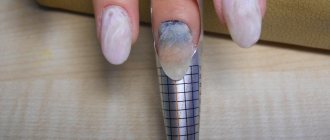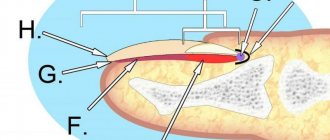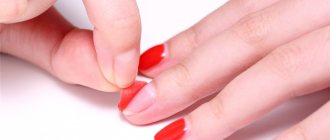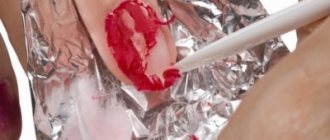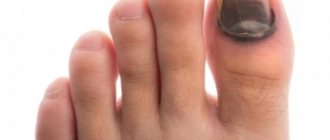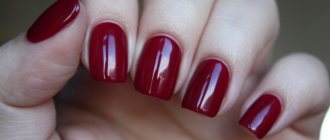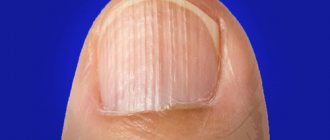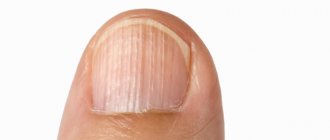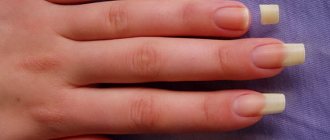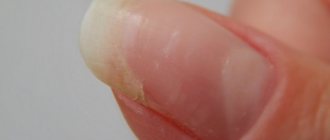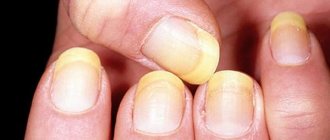Nail diseases are widespread. Many, seeing changes in the nail plate, do not know who to turn to for diagnosis, and miss precious time when they can correct something and get rid of the disease forever. Neglected cases lead to severe disease and irreversible consequences.
Women with long-term use of gel polishes, patients with anemia or protein-energy deficiency often experience splitting of the nail plate. Understanding the causes and finding out which direction to move when identifying nail diseases is very important, as this can help in diagnosing more dangerous conditions.
Acquired onychodystrophy often takes the form of onycholysis. This pathology is characterized by a change and lack of connection between the plate and the bed; the matrix remains intact. Detachment of the nail from the distal edge is observed when the nail plate is unable to adhere to the bed. Below we will analyze the main reasons for the development of onycholysis.
Why does the plate peel off from the nail bed and what does it mean?
Genetics
In people suffering from autoimmune diseases, there is a hyperreaction of the immune system with the subsequent development of autoimmune inflammation and disruption of the integrity of healthy tissues.
The following symptoms are typical for this type of disease :
- thickening and deformation;
- rough surface;
- delamination;
- dullness of the nail with dotted, linear white or black inclusions;
- change in shape, similar to a saucer in the center of the nail;
- inflammation of the cuticle.
Poor quality care and manicure
When performing a manicure, the master must comply with all sanitary and hygienic rules for serving the client. Manicure instruments must undergo mandatory sterilization and disinfection.
Detachment of the nail plate can occur both after salon procedures and as a result of inappropriate care at home, for example:
- too frequent nail extensions and gel polish application;
- low-quality nail care products;
- using nail polish remover with acetone;
- inaccurate filing of nails - it is not recommended to move the file in different directions; you need to hold the tool at an acute angle to the nail plate;
- mistakes when removing nail polish.
Work specifics
Harmful working conditions can also cause nail peeling. Diseases can be caused by dangerous components included in household chemicals, as well as by mechanical factors and damage to nails when performing the same work with your hands.
The following professions deserve special attention:
- typist;
- cook;
- hairdresser;
- workers;
- cleaners;
- employees of laundries, dry cleaners, car washes.
The main symptoms of onycholysis associated with work activities:
- yellow tint of nails;
- longitudinal grooves of the nail;
- lack of smoothness and shine;
- impressions of the nail plate;
- fragility and porosity of the nail;
- splitting of the nail plate in the transverse direction.
Lack of vitamins
The development of vitamin deficiency disrupts the structure of the posterior part of the nail plate - the matrix. Externally, a lack of vitamins (vitaminosis) affects differently :
- separation of the nail surface;
- the appearance of white transverse stripes;
- mottled with yellowish stripes;
- yellow nails;
- fragility and curvature;
- the presence of shapeless spots or inclusions.
Nervousness
Nervousness triggers the development of many diseases. Symptoms associated with mental imbalance sometimes manifest as:
- growths of the nail;
- fragility;
- whitish-blurred nail color;
- uneven and rough surfaces;
- inflammation of the cuticle.
Hand injuries
If the hands are injured, the nail plate may be torn off. However, this area is characterized by rejection of the nail sheet over time, not immediately. The most typical types of impacts and injuries :
- pinched finger;
- injury;
- compression.
Therapy for injuries is a long process: the nail grows back over several months.
Often an overgrown nail shows signs of deformation.:
- lack of connection between the outer edge and the bed;
- partial bifurcation of the nail during growth transversely or longitudinally;
- depressions;
- saucer-shaped deformities;
- whitish or dark spots.
Hormonal imbalances
And nails are no exception! Malfunctions of the thyroid gland have the most significant effect , causing nail detachment.
Typical violations:
- fragility and brittleness of nails;
- porosity and unevenness of the plates;
- loose nail surface;
- yellowing and fading.
Fungus
In first place among the causes of split nails is fungus (forty percent of the total number of diseases). According to modern scientific data, more than two hundred mycobacteria have been identified. The main action of the fungus is aimed at destroying bonds. Let's look at the characteristic features:
- rough and furrowed nail plate;
- yellowed and thickened;
- detachment of the nail from the inner edge;
- saucer-shaped notch in the center.
Medicines
- beta receptor blockers;
- antibiotics: fluoroquinolones and tetracycline;
- lithium preparations.
While taking it, the following nail growth disorders may occur::
- fragility;
- whitish-gray tint;
- formation of depressions;
- disturbances in the structure of the nail layers (thickening);
- appearance of roughness.
Diseases
There are a number of diseases, both acute and chronic, in which nail peeling can occur. The most common systemic diseases associated with this disease are the following :
- gastrointestinal, such as gastritis or ulcers;
- of cardio-vascular system;
- nervous system;
- endocrine disorders;
- skin diseases: atopic dermatitis, bullous dermatosis, eczema and psoriasis.
Causes of toenail falling off
If your nail has fallen off on your toe or hand, the first thing you need to do to fully restore it is to find out the reason for such destruction of the surface. Most often it is associated with problems with the matrix, but there are many factors that can affect the future condition of the legs.
Most often, such damage is associated with exposure to external factors:
- Mechanical damage. The factor occurs most often, especially on the legs, since pinching, severe bruising or fracture of the fingers/toes leads to deformation of the surface and poor circulation;
- Exposure to chemical components. When visiting a salon to apply a decorative coating, make sure of the quality of the compounds used, since low-quality solutions gradually destroy the nail;
- Wearing uncomfortable shoes. Girls often choose high-heeled shoes that squeeze their feet tightly. Their frequent wear leads to damage to the nail, which can lead to complete falling off.
However, if the nail fell off not due to external factors, the girl’s health condition may provoke the problem. The risk is associated with the fact that there are a large number of nerve endings in the tips of the toes, which is why internal problems often affect the quality of the pedicure.
There are several main internal factors that can lead to nail destruction:
- Fungal infection;
- Dermatological diseases of the feet;
- Decreased general or local immunity (after illness or long-term use of antibiotics);
- The presence of infection in the body, accompanied by inflammatory processes;
- Onycholosis. The disease is associated with the formation of voids in the structure of the nail, which completely deforms it and affects its overall quality.
Severe problems with a girl’s health always affect the condition of the pedicure area and the skin on her legs, so take this factor into account when recovering.
Diagnostics
The diagnosis of onycholysis is made by a dermatologist as follows::
- Visually. During examination, attention is paid to the presence of arched transverse grooves up to 1 mm deep (Bo lines).
They indicate the severity of the lesion, indicate frequent injuries or indicate the presence of somatic diseases.The number of affected nails, their color, shape, structure, and the condition of the plate help make a clinical diagnosis.
- Scraping of the nail bed is performed to diagnose the presence of pathogenic microorganisms. The study makes it possible to exclude or confirm mycotic or bacterial damage.
- At the end of the differential diagnosis, the symptoms identified in the patient are compared with signs of diseases such as:
- fungus;
- lichen;
- psoriasis;
- skin cancer;
- atypical onychodystrophies.
Forms and stages of onycholysis
There are several types of onycholysis:
- dermatological;
- traumatic;
- fungal;
- systemic;
- endocrine;
- allergic;
- bacterial.
Onycholysis can also be partial or complete. In the first option, the nail moves away from the nail bed only in a separate area, and in the second, the process can spread to the entire surface of the nail.
The disease occurs in stages:
- stage of disease development;
- stable stage without progression;
- subsidence of the dystrophic process;
- regression stage;
- complete recovery.
What processes can be identified during onycholysis?
- Rejection of the plate from the bed in the area of the leading edge, detachment from the side and at the base of the holes.
- A healthy nail is transparent; if it turns whitish-gray, then there is air in the bed space.
- A change in color in the yellow-brown palette helps to suspect the presence of microbes.
- The greenish color is characteristic of Pseudomonas aeruginosa.
- With mycosis, the smoothness of the nail surface is lost, roughness appears, and the nail is also easily deformed.
- Hyperkeratosis gradually forms due to dirt and dead cells entering the subungual space.
- There is a risk of secondary foci of infection.
- Onycholysis is characterized by both complete and partial rejection of the plate.
How long does it take for the nail plate to fully recover?
Treatment courses for nail detachment are long. The timing of treatment is related to the concepts of plate growth rate and their complete renewal. In cases not complicated by infection, the therapeutic period for the hands is up to 6 months. Therapy for mycoses takes from 3 to 12 months. , there is a relationship here with the difficulties of getting rid of fungal infection.
The prognosis for treatment is favorable, although lifelong cosmetic defects may occur.
The problem of nail plate detachment can only be solved if the necessary treatment is completed. It is worth considering that pathology in the hands can appear not only as an independent disease, but also as a result of the presence of systemic disorders in the body, which also need to be dealt with.
What to do?
If the cause of detachment is injury
In case of incomplete rejection of the nail sheet on the thumb and other fingers in case of mechanical damage, which is not uncommon, the following should be done:
- The affected nail is trimmed daily.
- After which they are treated with a disinfectant.
- The treated area should be covered with a bactericidal patch for the rest of the day.
Surgical methods are used for complete detachment or for a large area of damage . The intervention is carried out by opening the nail bed, removing hyperkeratotic masses, hematomas and the source of contamination.
After surgery, daily dressings are required with mandatory treatment with antibiotics and antiseptics. During the recovery period, solutions with gelatin are used, which have proven to be a very effective remedy.
Microbial damage
Streptococcal or staphylococcal infection
Treatment is carried out using synthomycin gel and heliomycin ointment. Directions for use: treatment of the cuticle and affected area twice a day. Anti-inflammatory drugs are also used in addition to the main treatment.
Effective for local treatment:
- Levomekol ointment;
- preparations based on birch tar;
- Vishnevsky ointment.
Lotions and glycerin dressings are also used.
Candidal mycosis
Basis of therapy: antimicrobial drugs such as:
- “Mikospor” (“Bifonazole”);
- “Loceryl” (varnish is applied once a day);
- “Ketonazole”;
- “Itrazol”, “Itramikol”;
- “Batrafen” (varnish-based ciclopirox).
The use of Exoderil has shown its antifungal effect better than others . The drug is applied to the infected area and nearby areas twice a day.
In severe cases of the disease, antifungal drugs should also be used orally.
Systemic diseases
In this case, onycholysis therapy primarily involves treating the underlying disease that caused the peeling of the nail plates.
Stages of treatment of the disease:
- Vitamin therapy - taking vitamins (C, A, group B, beta-carotene) and microelements (iron, calcium, sulfur, zinc, copper).
- Application of “Solcoseryl” (ointment for external use). The product belongs to the group of biogenic stimulants and activators of metabolism in tissues and has powerful regenerating properties.
- Antihistamines.
- Physiotherapy.
- Nutrition.
If the disease was caused by an allergy or pathology of the digestive system, then it is appropriate to resort to diet therapy.
Can be used as therapy:
- vitamin and mineral complexes;
- antihistamines;
- fish fat;
- Dietary supplements containing amino acids.
Poor nutrition causes slow growth of the nail plate, which leads to its deformation. Patients suffering from onycholysis should include the following nutritional components in the menu :
- gelatin;
- fresh fruits;
- boiled vegetables;
- animal and vegetable proteins;
- nuts, seeds.
Traditional methods of treating nail plate detachment
The main methods consist of taking strengthening baths and lotions.
Here are some recipes:
- Salt bath with potassium permanganate . Dilute a tablespoon of sea salt with hot water and leave for half an hour, then immerse your hands in it. After the bath, wipe your hands dry and apply the medicine.
- Lotion with a paste of oil and garlic . Chopped garlic (5 cloves) is mixed with butter in equal proportions and rubbed into the affected area.
- Iodine . Just apply to your nail plates overnight.
- Propolis is used in the form of night lotions from its infusion.
- Herbal decoction:
- A mixture is prepared from equal proportions of dried oak bark, celandine herb, lilac and calendula flowers.
- The mixture obtained and thoroughly mixed is poured with hot water (temperature about ninety degrees).
- Then the resulting mixture should be placed on the stove and simmered for about ten minutes.
- Then the broth is cooled to room temperature and a twenty-minute therapeutic immersion of the hands is performed.
- Self-massage of fingers . This is done daily. Slowly, gently massage the nails in circular diverging movements in the direction of growth of the nail plate, working more diligently on the fingers with affected nails.
- Gelatin baths . About three grams of gelatin is poured into two hundred milliliters for half an hour. The solution is heated until the gelatin is completely dissolved (without boiling), after which it is cooled. Baths are carried out three times a week.
What to do if a toenail falls off?
Treatment should begin with a visit to a dermatologist or pathologist, so that the doctor examines the damaged area and prescribes a rehabilitation regimen. Since the nail has already fallen off, it will not grow back spontaneously, which is why going to the hospital is a mandatory step for a woman.
If the nail does not fall off completely, the doctor usually prescribes vitamin complexes and the use of local compresses that will fix the affected area. Sometimes in this case, surgical removal of the plate is prescribed, which will prevent the emergence of pathogenic microflora on it, which can damage the matrix.
If the matrix (base) of the toenail remains healthy, complex therapy is prescribed for the gradual regrowth of the coating:
- Perform steam baths daily. Add sea salt, baking soda, essential oil, and potassium permanganate to them.
- Every day before going to bed, wipe the surface with iodine.
- Use restorative, strengthening varnishes (Loceryl) and ointments that will speed up nail restoration (Nailtivit).
- In the presence of a fungal infection, antimycotics are prescribed - Lamisil, Exoderil, Mikozan.
- In case of dysfunction of organs or systems in a girl’s body, the doctor prescribes appropriate medications.
If you fully comply with the doctor's instructions, you can restore a natural pedicure 3-4 months before the surface completely regrows.
Recovery
Recovery time depends on the severity of the injury and the speed of recovery.
- In cases of non-infectious etiology, therapy lasts up to six months.
- The treatment period for mycotic lesions lasts from three months to a year. Treatment must be complete, only then is absolute recovery possible.
- If onycholysis appears as a result of existing diseases, then complex treatment is prescribed and the treatment process becomes more complicated.
- The growth of new nail plates lasts on average from 3 to 5 months.
Folk remedies
In folk medicine, there are a sufficient number of recipes for combating nail detachment, based on strengthening baths and lotions, which are summarized in the table.
| Means | Mode of application |
| Salt bath with potassium permanganate | For 20-30 minutes. A bath is made in which 1-2 grams are dissolved. potassium permanganate and 1 tbsp. l. sea salt. Then the hands are dried and a medicinal ointment is applied to the affected areas. |
| Lotion with a mixture of oil and garlic | It is necessary to crush 5 cloves of garlic and mix with butter in a 1:1 ratio. The mixture is applied to the affected area, rubbing in. |
| Iodine | The nail plates are smeared with the product overnight. |
| Propolis | Propolis tincture with alcohol is used as a night lotion. |
| Herbal bath with oak bark | 3 tbsp. l. bark mixed with 1 tbsp. l. celandine, 1 tbsp. l. lilac flowers, 1 tbsp. l. calendula. The mixture is poured into 2 tbsp. boiling water and heat in a water bath for about 10 minutes. In the prepared solution for 20 minutes. make baths. |
Prevention
In matters of prevention, methods and regularity of daily care for the skin and nails of the hands are given first place. The main points are moisturizing the skin of the hands and performing a manicure in a timely manner.
If self-examination reveals any changes in the nail plate, you should immediately consult a doctor and remember whether there were any traumatic effects in this area.
Prevention rules:
- cleanliness;
- careful treatment of nails and absence of injuries;
- use of quality care products;
- Wear gloves when working with harmful chemicals;
- good nutrition;
- absence of negative psychological factors, lack of sleep;
- maintenance therapy of chronic diseases.
If you still suspect the presence of onycholysis, you should immediately consult a specialist. At the initial stage, the prognosis is very favorable, but taking into account possible complications in the form of cosmetic defects.
Treatment
To completely restore your nails, you need to promptly begin to eliminate the reason why they begin to peel off. Since the problem is not just a cosmetic defect, it develops in an open form, so a woman can notice it almost immediately and begin treatment in a timely manner.
The first signs of symptoms can be detected 1-2 days after the pathogen appears, which simplifies the process of rehabilitation of the pedicure area. Symptoms begin with a slight detachment of the nails, their significant thinning or thickening and short-term preservation of the decorative coating.
In the initial stages, you can restore the coating yourself; to do this, follow the following procedure:
- Balance your diet. To do this, be sure to include cereals, cereals, vegetables, and reduce fat intake. Additionally, it is recommended to add vitamin courses to improve immunity.
- Take steam baths daily. It is recommended to add auxiliary components to them: sea salt, potassium permanganate, baking soda, essential oils.
- Wipe the affected area with iodine every day before going to bed.
- If the surface is damaged due to injury, pay attention to personal hygiene. To do this, you need to wash your feet 2 times a day and wipe your finger with an antiseptic every 2-3 hours.
- Use medicated varnishes to strengthen the surface (for example, Loceryl).
The more attention you pay to restoring the pedicure area, the higher the chance of preventing complications.
Causes and risk factors
The etiology of the disease is based on infection of the nails by pathogenic fungi, including:
- dermatophytes (T. rubrum, T. interdigitale);
- yeast of the genus Candida (C. aibicans, C. tropicalis);
- mold fungi (Fusaria, Alternaria).
In addition to the main cause of the disease, there are a number of predisposing factors that increase the risk of developing onychomycosis. The trigger for the activation of a fungal infection can be:
- lack of nail care;
- diabetes;
- varicose veins;
- obesity;
- injuries;
- wearing tight shoes;
- poor quality pedicure;
- taking potent drugs.
Particular attention in the development of the disease is given to the state of the immune system. With strong immunity, the human body will be able to resist pathogenic flora even after it penetrates the body, but if immunity is reduced, fungal mycelium easily penetrates the epithelium of the nail, which causes inflammatory and dystrophic changes.
Nail fungus should not be considered as an aesthetic problem, since the toxins released by fungi can spread throughout the entire body and cause a number of concomitant diseases.
Photo: Symptoms of fungal nail infection
Abuse of gel polish
Why do nails come off after removing gel polish? Materials for glossy manicure consist of chemicals that can be quickly dried under ultraviolet rays. When applied to the nail, the base and other components harden and tighten the surface layer of the nail plate, which gradually leads to the nail moving away from the skin. In addition, before applying the base layer, it is necessary to degrease the surface and apply adhesive agents for better adhesion.
Healing varnish
A kind of “sealing” of the nail leads to a chronic lack of oxygen and nutrients. The hyponychium (subungual tissue) is depleted and the keratin bonds with the nail weaken, and epithelial atrophy occurs. After removing the gel polish, women note that the plate has moved away from the skin. A typical picture is the appearance of white or yellow lateral spots that tend to spread.
If applied incorrectly, the skin of the fingers may also suffer if the gel polish spreads and an allergy develops.
Tea tree oil
